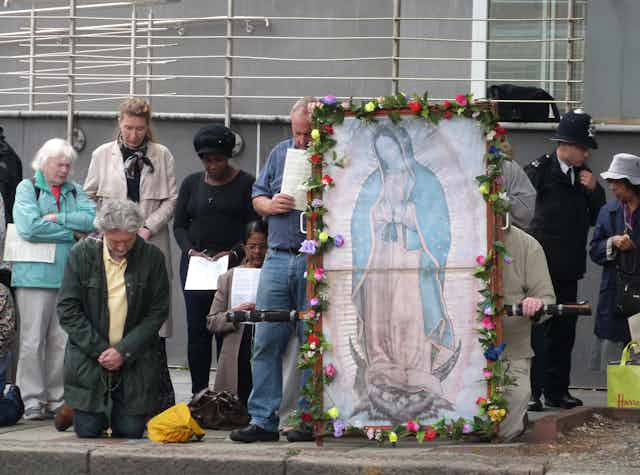If you’ve ever come across an anti-abortion protest, particularly outside of a clinic, you may have been struck by the use of the Virgin Mary. Images of Mary and other religious signs and symbols are frequently used in anti-abortion activism in Britain, as in other countries*.
At one level this is understandable because, as our research has shown, anti-abortion activists in the UK are overwhelmingly highly religious, with most aligned with conservative forms of Catholicism and a smaller number of evangelicals. Yet the use of these images also reveals important information about the activists’ motivations and understandings, such as ideas about the nature of women. And many Catholics are concerned about the way their religion is being portrayed.
The Catholic image of Our Lady of Guadalupe appears on everything from clothing to jewellery to shopping bags. Our Lady of Guadalupe is a specific, Mexican variation of the Virgin Mary. She depicts Mary as pregnant and has been given the title of “the protectress of the unborn”.
Catholic activists we spoke to said that Mary was important in their campaign as someone who proceeded with an unplanned pregnancy. So Our Lady of Guadalupe is a good representation of their cause.
There was also a particular colonial understanding of Our Lady of Guadalupe’s role in converting Mexico to Christianity, linked to the activists’ ideas about child sacrifice. They mentioned how Our Lady of Guadalupe’s apparition was central to Christianity displacing the “pagan” Aztecs, who they believed sacrificed children.
One participant went as far as to say that Mary enabled Mexicans to convert to the “true religion”. This position is in line with the colonial mentality at the time, which exaggerated and distorted indigenous practices to justify subjugating whole populations.
Activists we spoke to linked child sacrifice and abortion and believe these to be the same thing. For these activists, Our Lady of Guadalupe visually represents opposition to abortion and is therefore really significant to their campaign.
But despite the beliefs of anti-abortion activists, there is no singular meaning of Our Lady of Guadalupe. All religious interpretations are disputed, and images can be used for many different reasons.
Our Lady of Guadalupe is often used to represent Mexican identity. Mexican prisoners are known to deploy her image in tattoos. And she has also been an icon for the queer community.
In these instances, her connection to abortion is absent, and we think that this is a surprise to many of the anti-abortion activists who promote her image.
Misuse of religious symbols
British Catholics are often unhappy with the ways anti-abortion activists use Catholic imagery. The majority of British Catholics support abortion in at least some circumstances. Only a minority follow the strict Vatican teaching which is against abortion in all circumstances, including rape.
Our latest research with Catholic parishioners reveals that they are particularly unhappy about anti-abortion activism at clinic sites. This is because they see this as harassment of service users and staff, as well as a public nuisance to the local people who live around abortion clinics.

Like most people in Britain, they think that “safe access zones” are needed to prevent any form of abortion protest in the vicinity of clinics.
Some Catholic parishioners told us that anti-abortion activism at clinics involving prayer like the Rosary was a “misuse of prayer” and preyed on women who might be vulnerable. They are concerned about the overall image that this gave to Catholicism, especially when objects connected to Catholicism – such as rosary beads – are used.
Rather than following the teaching of the church – that abortion is always wrong – these Catholics felt individual conscience was key to abortion decisions. They also often emphasised the importance of recognising that reproductive decisions are made within the broader context of people’s lives.
Of those who were against abortion, many still did not think it was the right of anti-abortion activists to display their theological viewpoint outside of clinic sites. Instead, parishioners felt that people needed to determine what their moral stance on abortion was through their relationship with God.
Overall, rather than adopting a secular interpretation of abortion, Catholic parishioners used Catholic theology to interpret their perspective on abortion. This often led to a negative perception of anti-abortion activists.
The multiple Catholic viewpoints on abortion mean that an image such as the Virgin Mary does not have the same meaning to all those who display and see it. Even the same images of the Virgin Mary can have many different, and contrasting, interpretations.
It is important to recognise that, while religiously motivated anti-abortion activists often dominate the abortion discourse, they represent only a small minority of viewpoints within the broader Christian church.

Looking for something good? Cut through the noise with a carefully curated selection of the latest releases, live events and exhibitions, straight to your inbox every fortnight, on Fridays. Sign up here.

